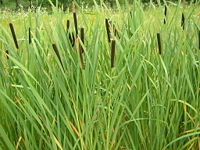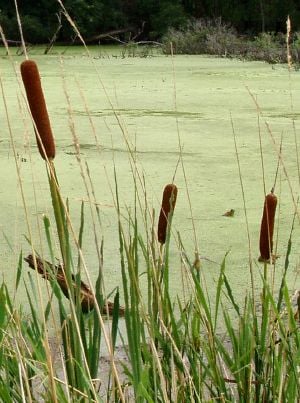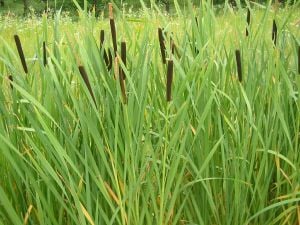Typha
| Typha | ||||||||||||
|---|---|---|---|---|---|---|---|---|---|---|---|---|
 Typha latifolia
| ||||||||||||
| Scientific classification | ||||||||||||
| ||||||||||||
|
See text |
Typha is a genus of perennial herbaceous plants in the Typhaceae family, characterized by long, spongy, strap-like leaves, clusters of minute flowers arranged in a dense, cylindrical spike, and the corresponding minute fruits in the form of a cylindrical, brown, furry spike. These reedy, wind-pollinated marsh plants are are variously known as cattails, bulrushes (or bullrushes), reedmaces (or reed maces), and club rushes. They are common in wetland areas in temperate and cold regions of both Northern and Southern Hemisphere. There are eleven extant species.
Overview and description
The Typha genus is placed in the Typhaceae family. The APG II system, of 2003 (unchanged from the APG system, 1998), also recognizes this family, and assigns it to the order Poales in the clade commelinids, in the monocots. The Cronquist system, of 1981, also recognized such a family and placed it in the order Typhales, in the subclass Commelinidae in class Liliopsida in division Magnoliophyta. While some taxonomies recognize Typhaceae as being monogeneric, including only Typha, ome classifications now include the genus Sparganium (Sparganiaceae) in Typhaceae, whereas previously it was placed alone in the family Sparganiaceae.. Sparganium ('Bur-reed), which also are perennial marsh plants, contains about 20 species in temperate regions of both the Northern and Southern Hemispheres.
There are about eleven species in the Typha genus. These monocotyledonous flowering plants has a largely Northern Hemisphere distribution, but is essentially cosmopolitan, being found in a variety of wetland habitats. These plants are known in British English as bulrush, bullrush or reedmace (Sterry and Sterry 2008), and in American English as cattail, punks, or corndog grass. Cattails should not be confused with the bulrush of the genus Scirpus.
Cattails are wetland plants, typically 1 to 7 m tall (T. minima is smaller: 0.5-1 m), with spongy, strap-like leaves and starchy, creeping stems (rhizomes). The leaves are alternate and mostly basal to a simple, jointless stem that eventually bears the flowers. The rhizomes spread horizontally beneath the surface of muddy ground to start new upright growth, and the spread of cattails is an important part of the process of open water bodies being converted to vegetated marshland and eventually dry land.
Typha plants are monoecious, wind-pollinated, and bear unisexual flowers developing in dense, complex spikes. The male flower spike develops at the top of the vertical stem, above the female flower spike (see figure below). The male (staminate) flowers are reduced to a pair of stamens and hairs and wither once the pollen is shed, leaving a short, bare stem portion above the female inflorescence. The dense cluster of female flowers forms a cylindrical spike some 10 to as much as 40 cm long and 1 to 4 cm broad. Seeds are minute (about 0.2 mm long), and attached to a thin hair or stalk, which effects wind dispersal. Typha are often among the first wetland plants to colonize areas of newly exposed wet mud.
Species
- Typha angustifolia - Lesser Bulrush or Narrow Leaf Cattail
- Typha angustifolia x T. latifolia - Hybrid or White Cattail
- Typha domingensis - Southern Cattail
- Typha latifolia - Common Cattail
- Typha laxmannii - Laxman's Bulrush
- Typha minima - Dwarf Bulrush
- Typha orientalis and Typha muelleri[1] - Raupo
- Typha shuttleworthii - Shuttleworth's Bulrush
The most widespread species is Typha latifolia, extending across the entire temperate Northern Hemisphere. T. angustifolia is nearly as widespread, but does not extend so far north. T. domingensis is a more southerly American species, extending from the U.S. to South America, while T. laxmannii, T. minima and T. shuttleworthii are largely restricted to Asia and parts of southern Europe.
Typha plants grow along lake margins and in marshes, often in dense colonies, and are sometimes considered a weed in managed wetlands. The plant's root systems help prevent erosion, and the plants themselves are often home to many insects, birds and amphibians.
In North America, the native cattails are increasingly being supplanted by the invasive purple loosestrife Lythrum salicaria.
Edible uses
Cattail has a wide variety of parts that are edible to humans. The rhizomes are a pleasant, nutritious and energy-rich food source, generally harvested from late Fall to early Spring. These are starchy, but also fibrous, so the starch must be scraped or sucked from the tough fibers. In addition to the rhizomes, cattails have little-known, underground, lateral stems that are quite tasty. In late spring, the bases of the leaves, while they are young and tender, can be eaten raw or cooked. As the flower spike is developing in early summer, it can be broken off and eaten, and in mid-summer, once the flowers are mature, the pollen can be collected and used as a flour supplement or thickener.
Stuffing
The disintegrating heads are used by some birds to line their nests. The downy material was also used by Native Americans as tinder for starting fires.
Native American tribes also used cattail down to line moccasins and papoose boards. An Indian name for cattail meant, “fruit for papoose’s bed”. Today some people still use cattail down to stuff clothing items and pillows. [2]
The down has also been used to fill life vests in the same manner as kapok.
If using the cattail for pillow stuffing, it is suggested to use thick batting material, as the fluff may cause a skin reaction similar to urticaria.
Source of Ethanol
Although corn is usually the plant thought of to produce ethanol, cattails can also create it. Furthermore, cattails do not require much, if any, maintenance.[3]
ReferencesISBN links support NWE through referral fees
- ↑ http://www.esperanto.org.nz/anzed/r.html
- ↑ http://www.cattails.wordpress.com
- ↑ Heldreth, David, "Cattails can be Ethanol Source", Blue Mountain Eagle, August 11, 2008. Retrieved 2008-08-21.
Sterry, Paul, and Paul Sterry. 2008. Collins complete guide to British wildlife: a photographic guide to every common species. Complete British guides. London: Collins.
Credits
New World Encyclopedia writers and editors rewrote and completed the Wikipedia article in accordance with New World Encyclopedia standards. This article abides by terms of the Creative Commons CC-by-sa 3.0 License (CC-by-sa), which may be used and disseminated with proper attribution. Credit is due under the terms of this license that can reference both the New World Encyclopedia contributors and the selfless volunteer contributors of the Wikimedia Foundation. To cite this article click here for a list of acceptable citing formats.The history of earlier contributions by wikipedians is accessible to researchers here:
The history of this article since it was imported to New World Encyclopedia:
Note: Some restrictions may apply to use of individual images which are separately licensed.

